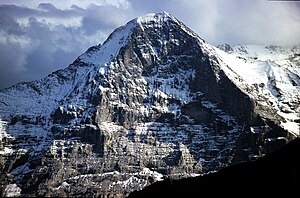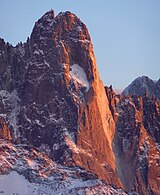Great north faces of the Alps
This article may be expanded with text translated from the corresponding article in German. (July 2012) Click [show] for important translation instructions.
|

In mountaineering, the six great north faces of the Alps (also called the six 'classic north faces') are known for their difficulty and great height. A face is "a vertical or sloping side of a mountain or cliff."[1]
They are (sorted by date of first ascent):
- Matterhorn, first ascent in August 1931;
- Cima Grande di Lavaredo, first ascent in 1933;
- Petit Dru, first ascent in 1935;
- Piz Badile, first ascent July 1937;
- Eiger, first ascent in July 1938;
- Grandes Jorasses, first ascent in August 1938.
Making the first ascent of each of these six faces was a major preoccupation of the best European climbers in the 1930s. Gaston Rébuffat, a French alpinist and mountain guide, was the first to climb all six of them, and his 1954 work, Etoiles et Tempêtes (Starlight and Storm), chronicles these climbs.[2]
Three of these north faces — the Eiger, the Matterhorn and the Grandes Jorasses — are considerably harder to climb than the others. This led to their becoming known as 'the Trilogy'.
Records[]
The first to climb these three faces within a year was the Austrian , from the summer of 1961 to the summer of 1962. Ivano Ghirardini was the first man to climb the Trilogy in winter, solo (1977–78), and Catherine Destivelle was the first woman (1992-93-94).[3] With the introduction of the concept of enchainment, the next challenge was to climb all three faces in one outing, a race eventually won by , who achieved the feat between 11–12 March 1987 in a time of 24 hours.[4]
From December 2014 to March 2015, during a project known as "Starlight and Storms", Tom Ballard climbed these six north faces solo, being the first person to complete this feat in a single winter season without a support team.[5] A film chronicling this project, Tom, won several awards at international film festivals.[6][7]
On 15 August 2021, with his ascent of the Petit Dru in 1 hour 43 minutes, the Swiss climber completed a ten-year project to make the fastest solo speed climb of all six faces. He had previously set speed records on the other five faces, with Ueli Steck's 2015 solo of the Eiger north face the only current faster ascent (when Arnold climbed the Eiger north face in 2011 in two hours and 28 minutes it was the fastest at that date).[8]
Gallery[]

The northern side of the Eiger

The northern side of the Grandes Jorasses

The northern side of the Matterhorn

The north-east face of Piz Badile

The northern side of the Petit Dru with the ice-field of 'the Niche' clearly visible
The northern side of Cima Grande di Lavaredo
Bibliography[]
- Anker, Daniel (ed.) (2000) Eiger: The Vertical Arena. Seattle: The Mountaineers.
- Bonatti, Walter (2001). The Mountains of My Life. New York: Modern Library. ISBN 0-375-75640-X.
- Hargreaves, Alison (1995). A Hard Day's Summer: Six Classic North Faces Solo. London: Hodder & Stoughton. ISBN 0-340-60602-9
- Rébuffat, Gaston (1999). Starlight and Storm: The Conquest of the Great North Faces of the Alps. New York: Modern Library. ISBN 0-375-75506-3
- Destivelle, Catherine (2003). Ascensions, Arthaud (French) (ISBN 2-7003-9594-8)
- Destivelle, Catherine (2015). Rock Queen, Hayloft Publishing Ltd (ISBN 978-1910237076)
References[]
- ^ "face - definition of face in English | Oxford Dictionaries 2.2". Oxford Dictionaries | English. Retrieved 2017-04-30.
- ^ Rébuffat, Gaston (1999). Starlight and Storm: The Conquest of the Great North Faces of the Alps. New York: Modern Library. ISBN 0-375-75506-3.
- ^ Destivelle, Catherine (2003). "L'Eiger en solitaire et en hiver". Ascensions. Arthaud. p. 181. ISBN 2-7003-9594-8.
- ^ Mark Twight, Kiss Or Kill: Confessions of a Serial Climber, The Mountaineers Books, 2002, p. 33
- ^ Sawer, Patrick (26 February 2016). "Tom Ballard conquers the Alps 20 years after his mother's death on K2". The Telegraph. ISSN 0307-1235. Retrieved 3 March 2019.
- ^ ""Tom": il film sull'alpinista Ballard conquista i film festival internazionali della montagna". Fassa.com. 14 January 2016.
- ^ Elena Golatelli. Tom.
- ^ Clarke, Owen (29 September 2021). "Dani Arnold Completes Speed Solos of all Six Great North Faces of the Alps". Climbing.com. Retrieved 2 October 2021.
- Great north faces of the Alps
- Alps
- Lists of mountains of the Alps
- Mountaineering in the Alps
- Cliffs of Europe
- Mountaineering in Switzerland





